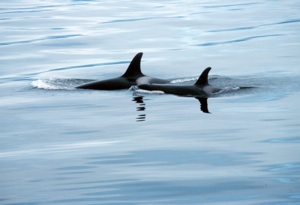Marine Mammal Species Description
Killer Whale
Orcinus orca
(Linnaeus, 1758)

Photo credit: Commander John Bortniak, NOAA Corps (ret.)
Classification
Order: Cetacea
Family: Delphinidae
Alternate Common Names: Orca, blackfish
Status: ESA Endangered/ MMPA Depleted
Description:
Length: maximum for males: 29.5 ft (9 m); maximum for females: 25.3 ft (7.7 m)
Weight: maximum for males: 14,550 lbs (6,600 kg); maximum for females: 10,360 lbs (4,700 kg)
Killer whales are the largest members of the dolphin family (Delphinidae). Males tend to be longer, heavier, and have longer fins and flippers than females. The dorsal fin of adult males is straight and triangular, and in females and younger individuals, it is more falcate shaped. They have a rounded head with a very short beak, their flippers are oval shaped. Killer whales are black on the upper parts and most of their sides. Killer whales are white underneath, except for their flippers, areas near their flippers, and an area of the tail stock. They have white patches on their sides near their anus and another oval-shaped patch near their eye. Just behind their dorsal fin they have a grey patch or saddle.
Habitat:
Killer whales occur at any water temperature and near shore or farther seaward (at all ocean depths), but they are more common in temperate waters that have a lot of available food. Pod (school) sizes for killer whales range from a few to more than 20 individuals. Pods are generally groups of closely related individuals. Some individuals remain with the pod in which they were born (their natal pod) for all of their lives.
Feeding:
Killer whales eat a wide variety of foods, including other marine mammals (except those that live primarily in freshwater), sea birds, sea turtles, fish, and squid. Killer whale pods are known to hunt for prey cooperatively, sometimes pushing their prey into shallows or onto land to catch them. Different pods of killer whales may specialize in eating only certain types of prey. One pod may specialize in eating marine mammals, and one pod in the same area may specialize on fish. This allows the two groups to feed in the same area without competing for food.
Reproduction:
Female killer whales reach sexual maturity at around 12-14 years, or about 15.1-17.7 ft (4.6-5.4 m) in length. Males reach sexual maturity when they are around 15 years old, about 17.1-20.3 ft (5.2-6.2 m) in length. The gestation period lasts from 15-18 months. Females typically give birth to one calf, which they nurse for about a year. Young become independent between one and two years old. Other non-reproductive males and females in a pod have also been documented caring for young calves within the pod.
Other:
There are a number of different recognized forms of the killer whale. In the future, these forms will likely be recognized as subspecies or possibly as new species. Individual killer whales have been recorded moving over large areas. Some have been documented moving over 1,243 miles (2,000 km) in the Pacific Ocean. The longest recorded dive of a killer whale lasted 17 minutes. Killer whales can swim as fast as 12.4 m/h (20 km/h). Faster speeds, sustained for shorter periods (up to 30 minutes), of 12.1 feet per second (3.7 m per second) were recorded for a pod of killer whales chasing a school of bluefin tuna (Thunnus thynnus). The average life span for a female killer whale is 50 years and for a male is 30 years old. The maximum documented life span for a killer whale is 90 years.
Distribution / Range:
Killer whales are found worldwide. They are the most widespread marine mammal. They are more abundant in areas with abundant food, at higher latitudes (farther from the equator) and closer to shore (within 497 miles (800 km)).
Similar species:
No other similar species.
Notes:
References:
American Cetacean Society. 2003. American Cetacean Society Fact Sheet. http://www.acsonline.org/factpack/KillerWhale.htm. Accessed January 2012.
Culik, B. 2010. Odontocetes. The toothed whales: "Orcinus orca". UNEP/CMS Secretariat, Bonn, Germany. http://www.cms.int/reports/small_cetaceans/index.htm. Accessed January 2012.
Ford J.K.B. 2009. Killer whale - Orcinus orca. In: Encyclopedia of Marine Mammals 2nd Ed. Perrin W.F., B. Würsig, and J.G.M. Thewissen, eds. Academic Press, New York, pp. 650-657.
Guinet C., P. Domenici, R. de Stephanis, L. Barrett-Lennard, J.K.B. Ford, and P. Verborgh. 2007. Killer whale predation on bluefin tuna: exploring the hypothesis of the endurance-exhaustion technique. Marine Ecology Progress Series 347: 111-119.
Heyning, J.E. 1999. Killer whale, Orcinus orca. In The Smithsonian Book of North American Mammals. Wilson, D.E. and S. Ruff, eds., 287-289. Smithsonian Institution in association with the American Society of Mammologists, Washington DC.
Taylor, B.L., Baird, R., Barlow, J., Dawson, S.M., Ford, J., Mead, J.G., Notarbartolo di Sciara, G., Wade, P. & Pitman, R.L. 2008. Orcinus orca. In: IUCN 2011. IUCN Red List of Threatened Species. Version 2011.2. www.iucnredlist.org. Downloaded on 09 January 2012.

 Marine Mammals of Georgia
Marine Mammals of Georgia